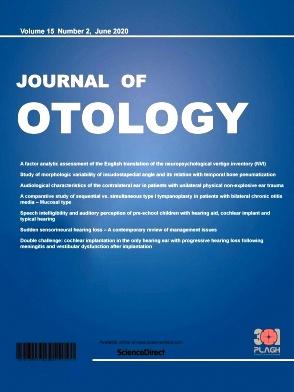硫胺素反应性巨幼细胞性贫血和耳聋:一例罗杰综合征患者通过人工耳蜗成功恢复听力。
IF 1.4
Q2 OTORHINOLARYNGOLOGY
引用次数: 0
摘要
硫胺素反应性巨幼细胞性贫血(TRMA),也称为罗杰综合征,是一种异常罕见的常染色体隐性遗传病,源于负责编码硫胺素载体蛋白的SLC19A2基因突变。该综合征表现为巨幼细胞性贫血、感音神经性听力损失和糖尿病的典型三联征。在这里,我们提出的情况下,一岁半的男婴出生的非近亲父母在印度,一个地区的TRMA病例很少报道。在5个月大时,患儿表现出特征性症状,需要立即治疗,包括硫胺素治疗、胰岛素治疗和输血。值得注意的是,除了听力损失外,该儿童在各方面都有显著改善,而传统助听器无法减轻听力损失。然而,在几个月内进行了人工耳蜗植入手术后,孩子恢复了听力。该病例强调了早期识别和人工耳蜗干预的重要性,证明了扭转TRMA症状的潜力,并为受影响的个体提供了显著改善的生活质量。本文章由计算机程序翻译,如有差异,请以英文原文为准。
Thiamine responsive megaloblastic Anemia and deafness: A rare case of Roger's syndrome with successful hearing rehabilitation by cochlear implantation
Thiamine responsive megaloblastic anemia (TRMA), also known as Roger's syndrome, is an exceptionally rare autosomal recessive disorder stemming from mutations in the SLC19A2 gene responsible for encoding a thiamine carrier protein.
This syndrome manifests as the classic triad of megaloblastic anemia, sensorineural hearing loss, and diabetes mellitus. Here, we present the case of a one-and-a-half-year-old male infant born to non-consanguineous parents in India, a region where TRMA cases are seldom reported. At five months of age, the child exhibited the characteristic symptoms, prompting immediate treatment involving thiamine therapy, insulin administration, and blood transfusions. Notably, the child exhibited significant improvement in all aspects except for hearing loss, which conventional hearing aids failed to alleviate. However, following a cochlear implant procedure conducted within a few months, the child regained hearing abilities. This case underscores the importance of early recognition and intervention in the form of cochlear implant, demonstrating the potential to reverse TRMA symptoms and provide affected individuals with a substantially improved quality of life.
求助全文
通过发布文献求助,成功后即可免费获取论文全文。
去求助
来源期刊

Journal of Otology
Medicine-Otorhinolaryngology
CiteScore
2.70
自引率
0.00%
发文量
461
审稿时长
18 days
期刊介绍:
Journal of Otology is an open access, peer-reviewed journal that publishes research findings from disciplines related to both clinical and basic science aspects of auditory and vestibular system and diseases of the ear. This journal welcomes submissions describing original experimental research that may improve our understanding of the mechanisms underlying problems of basic or clinical significance and treatment of patients with disorders of the auditory and vestibular systems. In addition to original papers the journal also offers invited review articles on current topics written by leading experts in the field. The journal is of primary importance for all scientists and practitioners interested in audiology, otology and neurotology, auditory neurosciences and related disciplines. Journal of Otology welcomes contributions from scholars in all countries and regions across the world.
 求助内容:
求助内容: 应助结果提醒方式:
应助结果提醒方式:


